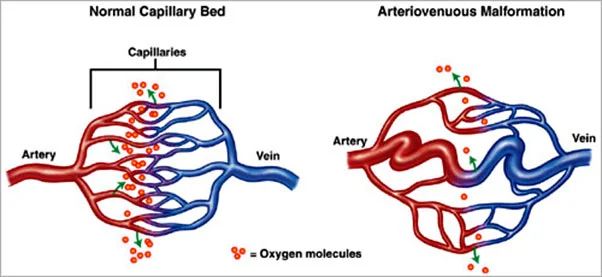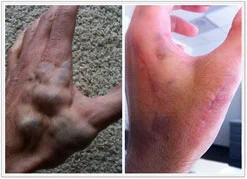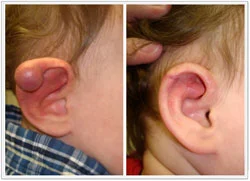Mobile
+91 8369559053
drsagputelimbandvesselcare@gmail.com
VASCULAR MALFORMATIONS
Vascular Malformations
Arteriovenous malformation is an abnormal connection between arteries and veins, bypassing the capillary system. This vascular anomaly is widely known because of its occurrence in the central nervous system (usually cerebral AVM), but can appear in any location. Although many AVMs are asymptomatic, they can cause intense pain or bleeding, disfigurement or lead to other serious medical problems.




Treatment
AVMs are benign, which means they are not cancer. Treatment of an AVM is focused on managing the symptoms and improving the life of the patient. There are no drugs yet that have been proven to cure an AVM.
A team of doctors will work together to treat an AVM. An interventional radiologist is a doctor who can read pictures and scans of the body and use these images to treat an AVM.
This doctor will play a role in both diagnosing and treating your AVM. Surgeons may also be involved.
The decision to treat an AVM is made by both the doctor and the patient. The age of the patient and the AVM’s size, location and stage are all part of the decision-making process. If an AVM isn’t causing problems (pain or loss of function) for the patient, then doctors may recommend just regular follow-up visits.
Because AVMs can expand over time, once an AVM starts causing problems, doctors will often start treatment. If an AVM is in a sensitive or dangerous area, doctors may discuss treatment sooner instead of waiting. Many patients with an AVM get treated when they are a child or teenager. Although some medicines are being tested for the treatment of AVM, there are no medicines that have been proven to treat an AVM.
Embolization and Sclerotherapy Treatment for AVMs
Embolization and sclerotherapy are the most common treatments for AVM. Embolization and sclerotherapy can reduce the size and symptoms of an AVM. They cannot make the AVM go away completely.
In embolization, materials such as medical glue, metal coils or even plugs are put into the center of the AVM through a tube called a catheter, which is inserted through a blood vessel.
These materials help to block blood flow. For an AVM, embolization is often done through an artery or a vein connected to the AVM. When an AVM is blocked, blood stops flowing into it, and this helps shrink the AVM.
In sclerotherapy, a liquid medicine called a sclerosant is injected into the AVM to destroy the vessels and cause scars to form. This process also leads to less or no blood flow through the AVM. Sclerotherapy is often used to treat other vascular malformations, such as venous malformations and lymphatic malformations as well.
During sclerotherapy, a doctor will use ultrasound and X-ray imaging to target the AVM.


Embolization and sclerotherapy are not cures for AVM, but rather, are used to manage AVM. They help with symptoms and make the AVM smaller. Over time, the AVM will likely re-expand. Most patients get this treatment several times throughout their life. The goal is to limit the symptoms as much as possible.
Sometimes, embolization and sclerotherapy to treat AVM are done together to get the best result.
Book Appointment
-
Varicose Veins & Varicose Ulcer Treatment
-
Non-Healing Wound Management
-
Vascular Malformations
-
Uterine Fibroid or Prostate Embolization
-
Cancer Treatments – TACE, RFA, Embolization
-
Dialysis Access Catherization
-
Diagnostic Procedures – FNAC, Biopsy, Diagnostic Angiography
-
Abscess Treatment - Aspiration, Pigtail Drainage
-
Treatment of Aneurysm and Stroke
-
Other USG, CT & DSA Guided Interventions
